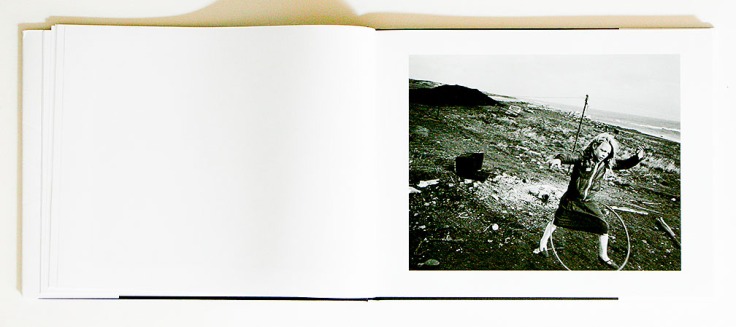
Copyright 2015 (2016) Chris Killip
Photographer: Christopher David “Chris” Killip (born; Douglas, Isle of Man, resides Boston, MA, USA)
Publisher: Steidl Verlag (Germany)
Essays: the book is without any essays, but does include an index of photographs at the conclusion.
Text: English
Hardcover book with dust jacket, sewn binding, four-color lithography, with index of photographs, printed in Germany
Photobook designer: Chris Killip and Victor Balko
Notes: In Flagrante Two is Steidl’s edition of Killip’s original photobook In Flagrante, which was a softcover book published in 1988 by Martin Secker & Warburg Ltd. Killip is investigating the working class neighborhood of northeast England over the duration of 1973 to 1985, a time of unrelenting economic troubles for the UK. Regretfully I have not have a copy of the original 1988 In Flagrante, but the frequent criticism of this first edition was that the horizontal two page spread design and printing lost some of the photographic content within the gutter. This large Steidl edition has each photographic image on one entire page, one printed page per spread and thus all of the photographic content is intact.
The photographs are very gray and gritty, the documentary style portrays an industrial area in a declining condition; an opening photograph of the Wallsend housing in Tyneside, cloaked in snow and at the conclusion of the book, the same advantage point during the demolition of this same housing track in Wallsend, with the bricks and rubbish littering the lane, similar to resulting the fall of Humpty Dumpty, who could not be put back together again by all of the King’s men. I should note that when corresponding with Killip, he revealed that the later photograph of the Wallsend housing demolition is one of three images that are new to the Steidl edition, which for me, makes this edition all that more compelling as a narrative of this time and place. I also note that Killip frequently photographed children who seem happy and oblivious to their dire surroundings, while the older youth and young adults appear to become very aware of their situation.
In my naivety of my English cousins, I had though In Flagrante was a reference to a region or place in northern England. Following up with Killip, he states that his book’s title is extracted from the term “In Flagrante Delicto”, a legal term meaning “caught in the act” in a sexual connotation, while In Flagrante is also caught in the act, but without a sexual connotation.
I had also read that many of the photographs of In Flagrante were made by Killip with a 4”x5”, but there was a spontaneity to the images that did not seemed to correspond to a static viewpoint of a view camera (my 4”x5” equipment assumption) on a tripod. In response to my question regarding the camera equipment he used, Killip stated that he mainly used a Linhof Technica 4”x5” hand-held which was mixed with 6×7 roll film taken on a Plaubel.
As to my question as to the overlap of his Seacoal images that are also included in In Flagrante, he responded; “I did the In Flagrante book a longtime before the Seacoal book and the Seacoal images that are in In Flagrante just seemed to fit.
Killip also states “In Flagrante Two is strident in its belief in the primacy of the photograph, embracing ambiguities and contradictions in an unadorned narrative sequence devoid of text.”
Other Chris Killip photobooks featured on The PhotoBook: Seacoal
Cheers










Nice book. I appreciate the lay-out.